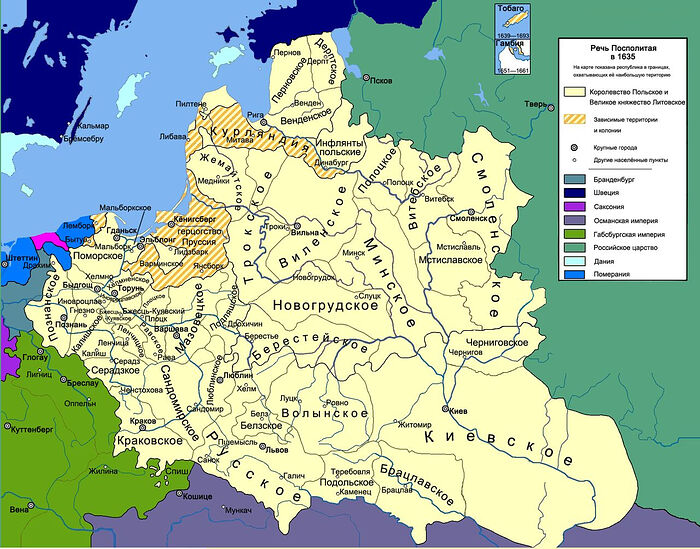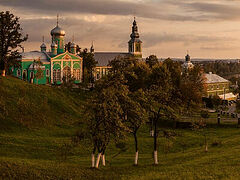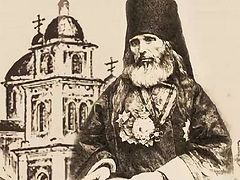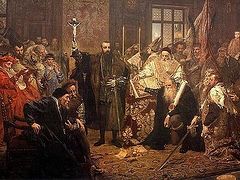We highly recommend that anyone wishing to understand what is now happening in the Ukrainian religious space to read this snippet of history of the state known as the Rzeczpospolita, or the Polish-Lithuanian Commonwealth. History has a way of repeating itself, and a pattern established in earlier times seems to be manifesting itself again on territory that was partially ruled by Polish kings four centuries ago.
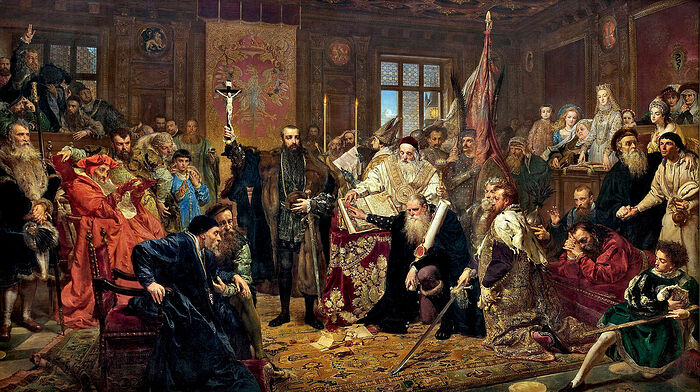 The Union of Lublin. Painting by Jan Matejko.
The Union of Lublin. Painting by Jan Matejko.
When the Union of Lublin was signed in 1569, Lithuania and Poland merged to form Rzeczpospolita, the largest European state whose size even exceeded Muscovy before the famous military campaigns of Ivan the Terrible.
In the east, Rzeczpospolita (also known as the Polish-Lithuanian Commonwealth) reached the border of the Tula region. In other words, the abattis on the Polish border were only about 200 kilometers away from Moscow, the capital of Muscovy.
At that time, the Popes in Europe, feeling that they were in hot water, seemed to have felt the need for action. Pope Paul III called for a Council that was held in Trent in 1545. Held in several sessions, the Council lasted almost twenty years and was adjourned in 1563 in the pontificate of Pope Pius IV. This Council was one of the most important Councils in the history of the Catholic Church. It is considered to be the starting point of the Counter-Reformation. The Council developed the strategy and tactics for the fight against Protestants, which also affected the Orthodox people of Rzeczpospolita. At that time, sporadic religious conflicts between Catholics and Protestants had been sending shockwaves through Europe for quite a long time, although the conflict hadn’t escalated yet—the infamous St. Bartholomew Day Massacre would not happen for another three years and the Thirty Years’ War would start much later. Meanwhile, Rzeczpospolita was a surprisingly peaceful haven in the religious fire that was devouring the neighbouring states one by one. Unlike the West that was home to the followers of only two Christian branches, Rzeczpospolita allowed for peaceful coexistence of three Christian denominations, including Catholics, Protestants and Orthodox, not to mention Jews and Muslims. People of that time who had witnessed incessant feuds and religious wars in “the civilized world” when cutting one’s throat or impaling on a stake for denominational differences was quite common even in the eternally neutral Switzerland, respectfully referred to Rzeczpospolita as “the land without the inquisition fires”. However, despite all this blissfulness, some undercurrents were going on in the Grand Duchy of Lithuania. The members of the Unity of the Brethren came here from Austria to enjoy the local liberties and religious freedoms, while the Sephardim and Ashkenazi came from Spain and German principalities to escape antisemitism. The latter were not proselytizing, but the Protestants weren’t twiddling their thumbs (they have kept their penchant for being active till these days). These new citizens of Rzeczpospolita and the Grand Duchy of Lithuania were relentlessly preaching in all cities and towns of their new homeland, trying to spread the newly acquired and hard-won truth about the way that “the real” Church should be, free from the conventionalities of the millennia-old traditions that supposedly bound the faith in an impenetrable armor. Their mission could be called successful, as by the last quarter of the sixteenth century more than forty percent of the parishes in Greater Poland had converted to Lutheranism. The other lands of Rzeczpospolita followed suit. Calvinism was more popular than Protestantism in Lesser Poland and Galicia, and by the end of the sixteenth century, when the first Cossack uprisings started, 206 to 297 Calvinist societies had been active in Lesser Poland and Ruthenian Voivodeship.
206 to 297 Calvinist societies had been active in Lesser Poland and Ruthenian Voivodeship
All these freedoms, including equal rights for Catholics, Orthodox, and Protestants, were guaranteed by the state decree of June 7, 1563. Moreover, in 1573 the Warsaw Confederation declared the total freedom of religion, solidifying the status of Rzeczpospolita as the most latitudinarian country in Europe. Obviously, the country could not exist in isolation, and the Protestants who came here to save their lives kept on tirelessly explaining and “preaching the truth” to native Poles and Lithuanians as well as to Russians.
But not everybody was happy with this freedom. The situation began to worsen gradually and eventually became very serious. This was made worse by the fact that with time, influential magnates and large landowners were converting to Protestantism, especially in Lithuania. For example, duke and chancellor Mikołaj “the Black” Radziwiłł and his cousin Mikołaj “the Red” Radziwiłł were among the first magnates to break their ties with Catholicism and Orthodoxy. At first, Mikołaj “the Black” Radziwiłł was interested in Lutheranism. Later, he started corresponding with Calvin himself. In 1557, he founded a Protestant church in Vilna, which was the first Protestant church in Lithuanian and Belarusian lands. Three years later, he gave all the churches located in his vast lands stretching from Nesvizh to Szydłowiec to Calvinists. Needless to say, the Radziwiłłs, as supreme rulers, were followed by all Lithuanian nobles. Catholicism, the endemic religion of the Poles, began to be ignored, ridiculed and even persecuted (as in the case of the cousins Radziwiłłs). Incidentally, following the example of the Union of the Brethren, the Radziwiłłs and their supporters started calling themselves the “Polish Brethren”. The “Lithuanian Brethren” was a similar organization. In essence, these Protestant doctrines were anti-Trinitarian, i.e. rejecting the Trinity and the divinity of Christ. In other words, they were basically Arian. Only one hundred years later, in 1658, all Arians were banished from Poland by the resolution of the Sejm of Rzeczpospolita.
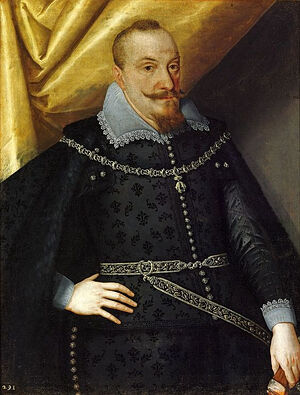 Jacob Troschel. The Portrait of Sigismund III Vasa, King of Poland, 1610s. King’s Castle in Warsaw. By 1587, Sigismund III Vasa had become the King of Poland. He was a devout Catholic brought up by Jesuits. They were the ones who influenced the king’s decision to do everything in his power to fortify Catholicism that was being repressed in Rzeczpospolita and launch a crusade against anybody who was confessing the Lord in a manner that was different from the dogma established by the Council of Trent. This became Sigismund III Vasa’s lifework.
Jacob Troschel. The Portrait of Sigismund III Vasa, King of Poland, 1610s. King’s Castle in Warsaw. By 1587, Sigismund III Vasa had become the King of Poland. He was a devout Catholic brought up by Jesuits. They were the ones who influenced the king’s decision to do everything in his power to fortify Catholicism that was being repressed in Rzeczpospolita and launch a crusade against anybody who was confessing the Lord in a manner that was different from the dogma established by the Council of Trent. This became Sigismund III Vasa’s lifework.
As a result of the incessant work of Jesuits and the king’s determination, all the promises and expectations of the state decrees on freedom of religion issued in 1563–1573 had been reneged on and later altogether abandoned. The Protestant magnates and influential state officials like the Radziwiłłs were quietly and carefully removed from power. “One nation, one faith” was the motto that defined the events that followed. The Jesuits convinced the king that in order to unify the nation and naturally overcome the national differences between the Poles, Lithuanians and Russians one should start with the unification of religion.
The Jesuits focused their activities on children, planning to raise faithful warriors of Rome, the future of Catholicism. The words of Christ, No man, having put his hand to the plough, and looking back, is fit for the kingdom of God (Luke, 9:62) were being interpreted literally. The elderly and middle-aged people were simply discarded and treated like unimportant things of the past, and their former merits and military victories that had made the expansion of the Polish-Lithuanian borders possible were ignored. This Jesuit tactic was later adopted by the totalitarian regimes that also exclusively banked on the youth. The examples include Pioneers and Komsomol members of the USSR in the 1920s; the Hong Wei Bing youth, the revolutionary students during the Cultural Revolution in the Communist China; and “the students” of the Islamic Revolution in the times of Ayatollah Khomeini. Similarly, “the students of madrassas” of Taliban in Afghanistan after the fall of the pro-Soviet regime of Najibullah are still believed to be “students” thirty or forty years later and keep on doing what their spiritual leaders had taught them to do… But Societas Jesu was seemingly the only society that had utilized the resources of the entire country to achieve the goals set by the Roman high priests.
The tactics and strategy were quite simple: the Jesuit schools, collegiums and universities offered an excellent education, and any father in his right mind wanted his sons to be educated and prosperous. The main condition for admission to the educational establishment was profession of Catholicism, a seemingly trifling matter. But believing this condition to be insignificant is a modern-day erroneous approach. If it were insignificant, there wouldn’t have been any religious wars during the sixteenth and seventeenth centuries. To be admitted to a decent school, a Lithuanian or a Russian youth had to denounce Lutheranism, Calvinism or Orthodoxy, and everything immediately became available to him, the Jesuits made sure of that. This practice had been used by Societas Jesu for many centuries.
The neighboring countries also kept king Sigismund on his toes, for they were “the enemies of Christianity”. The existence of Orthodox Muscovy and Protestant Sweden, along with the Protestants in Lithuania and Orthodox people of southwest Ruthenia (as this area was called in the historical terminology of the sixteenth century) meant that Societas Jesu had its work cut out for it, because the out and out war with these nations was the basis of both foreign and domestic policy of Sigismund.
However, these facts only outline the background for the subsequent fatal events, which are historically seen as inevitable and unfortunate because they had led the largest and richest country, formerly known as the “country without the inquisition fires” (bordering Tula region in the east and the duchy of Brandenburg in the west and incorporating even the duchy of Prussia, the lands of the once powerful Livonian Order) to the political collapse and irretrievable loss of a large segment of Orthodox lands, followed by frantic efforts to retrieve these lands at any cost, only to disappear from the political map of Europe for 123 years, or basically, forever. The great, glorious and magnificent Rzeczpospolita, the invincible White Eagle, the fearsome opponent of the gold two-headed eagle of Byzantine-Muscovy and the black, two-headed pointy-winged Teutonic eagle of the Habsburgs’ Empire or the Holy Roman Empire, disappeared into the abyss of historical oblivion, as if it had never existed two centuries after the triumphant march of Sigismund III and Societas Jesu and the bloodbath they had unleashed on their people.
The military, moral and administrative pressure, bribing of the Orthodox hierarchs, discrimination against the Orthodox nobles, the impossibility for non-Catholics to make even a minor government career, despotism, unprecedented oppression of subjects, harassment, humiliation and murder of the Orthodox clergy in southern Ruthenia, destruction of the Lutheran and Czech Cathedrals in Poznan, elimination of the heterodox cemetery in Krakow were met with the natural counteractions of opponents—such as the exile of Jesuits from Toruń and Danzig and numerous Cossack uprisings, which in my opinion marked the beginning of the

